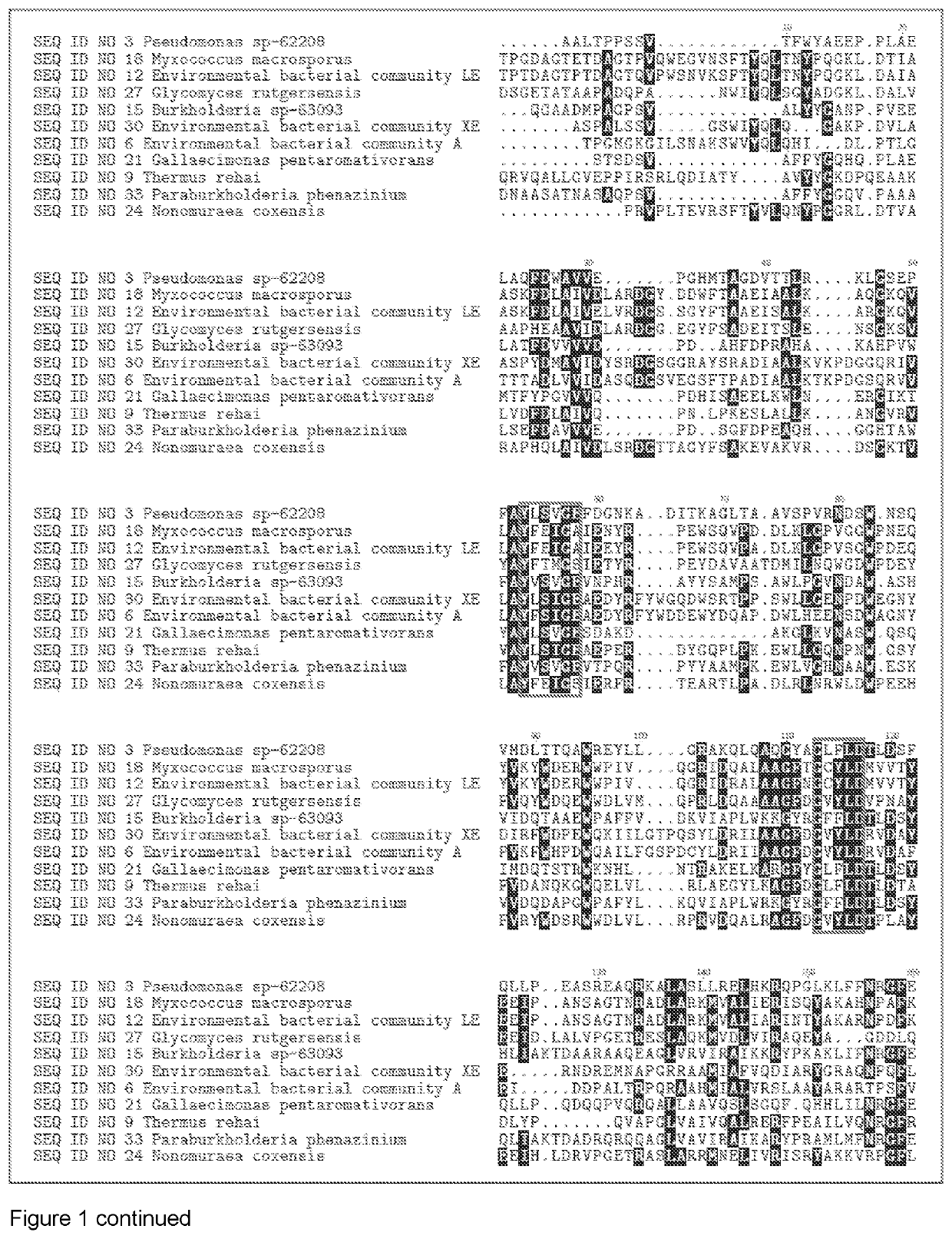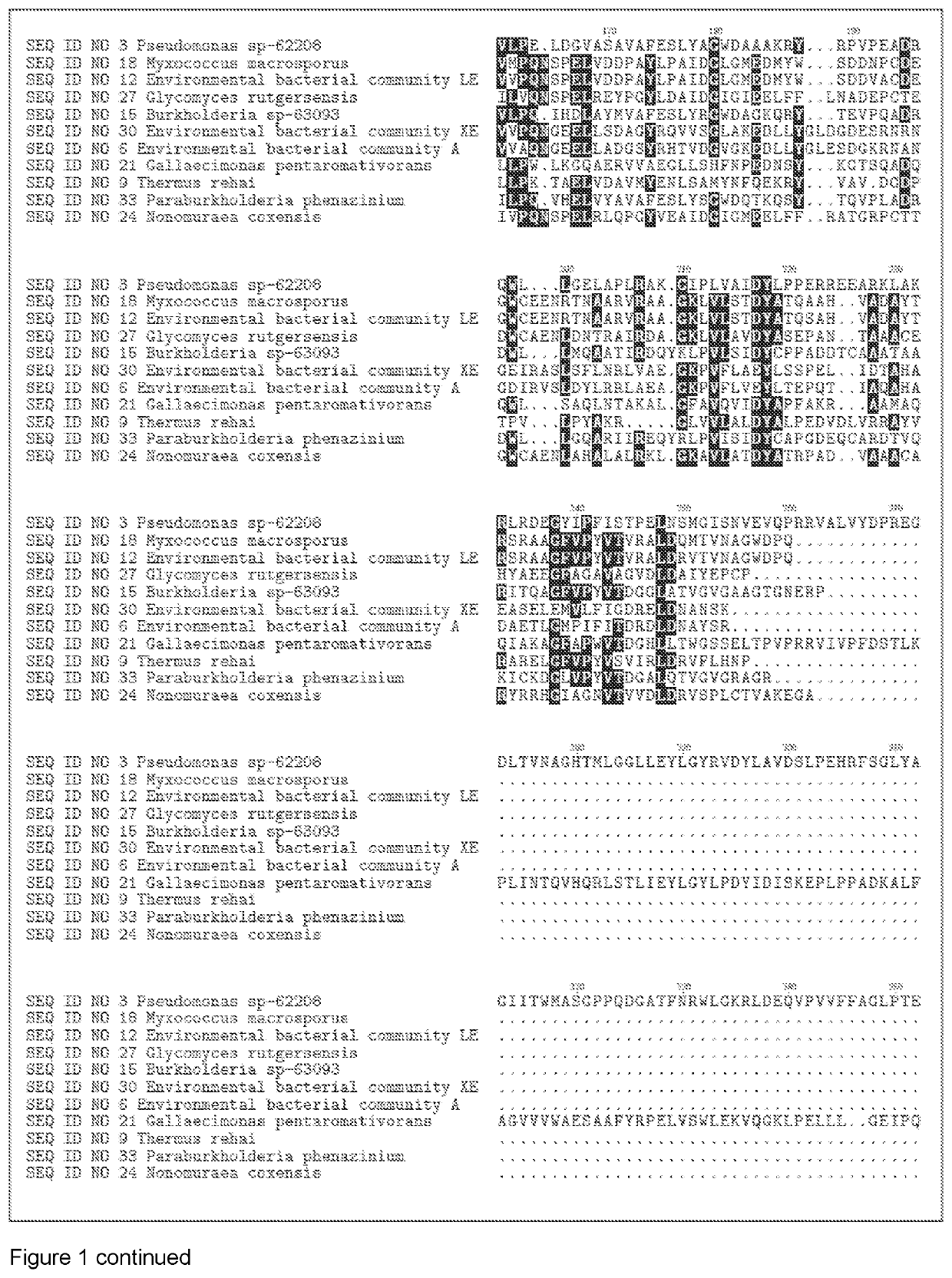Glycosyl hydrolases
a glycosyl hydrolase and glycosyl hydrolase technology, applied in the field of polypeptides, can solve the problems of textile greeping, malodor trapped within the organic structure, and biofilm is not desirable on textiles and surfaces associated with cleaning
- Summary
- Abstract
- Description
- Claims
- Application Information
AI Technical Summary
Benefits of technology
Problems solved by technology
Method used
Image
Examples
example 1
Cloning and Expression of Polypeptides
[1446]The DNA encoding the gene of SEQ ID NO 1, SEQ ID NO 4, SEQ ID NO 7, SEQ ID NO 10, SEQ ID NO 13, SEQ ID NO 16, SEQ ID NO 19, SEQ ID NO 22, SEQ ID NO 25, SEQ ID NO 28, SEQ ID NO 31, SEQ ID NO 3, SEQ ID NO 6, SEQ ID NO 9, SEQ ID NO 12, SEQ ID NO 15, SEQ ID NO 18, SEQ ID NO 21, SEQ ID NO 24, SEQ ID NO 27, SEQ ID NO 30, SEQ ID NO 33, SEQ ID NO 40, SEQ ID NO 43, SEQ ID NO 46, SEQ ID NO 49, SEQ ID NO 52, SEQ ID NO 55, SEQ ID NO 58, SEQ ID NO 61, SEQ ID NO 64, SEQ ID NO 67, SEQ ID NO 70, SEQ ID NO 73, SEQ ID NO 76, SEQ ID NO 79, SEQ ID NO 82, SEQ ID NO 85, SEQ ID NO 88, SEQ ID NO 91 and SEQ ID NO 94, were isolated from bacterial strains and environmental bacterial communities isolated from soil samples collected in different countries (see table 1).Chromosomal DNA from the different strains and bacterial communities was subjected to full genome sequencing using Illumina technology. The genome sequence was analyzed for protein sequences that that h...
example 2
Cloning and Expression of Polypeptides of the Invention
[1448]The DNA encoding the mature peptide of Glyco_hydro_114 genes SEQ ID NO 1, SEQ ID NO 4, SEQ ID NO 7, SEQ ID NO 10, SEQ ID NO 13, SEQ ID NO 16, SEQ ID NO 19, SEQ ID NO 22, SEQ ID NO 25, SEQ ID NO 28, SEQ ID NO 31, SEQ ID NO 38, SEQ ID NO 41, SEQ ID NO 44, SEQ ID NO 47, SEQ ID NO 50, SEQ ID NO 53, SEQ ID NO 56, SEQ ID NO 59, SEQ ID NO 62, SEQ ID NO 65, SEQ ID NO 68, SEQ ID NO 71, SEQ ID NO 74, SEQ ID NO 77, SEQ ID NO 80, SEQ ID NO 83, SEQ ID NO 86, SEQ ID NO 89, SEQ ID NO 92, were amplified from the genomic DNA of the corresponding bacterial strains by standard PCR techniques using specific primers containing an overhang to cloning vector. The amplified PCR fragments were inserted into a Bacillus expression vector as described in WO12 / 025577. Briefly, the DNA encoding the mature peptide of the gene was cloned in frame to a Bacillus clausii secretion signal (BcSP; with the following amino acid sequence: MKKPLGKIVASTALLISVAFSSS...
example 3
His Tag Purification Method
[1449]The His-tagged Glyco_hydro_114 enzymes were purified by immobilized metal chromatography (IMAC) using Ni2+ as the metal ion on 5 mL HisTrap Excel columns (GE Healthcare Life Sciences). The purification took place at pH 7 and the bound protein was eluted with imidazole. The purity of the purified enzymes was checked by SDS-PAGE and the concentration of the enzyme determined by Absorbance 280 nm after a buffer exchange in 50 mM HEPES, 100 mM NaCl pH7.0
PUM
 Login to View More
Login to View More Abstract
Description
Claims
Application Information
 Login to View More
Login to View More - R&D
- Intellectual Property
- Life Sciences
- Materials
- Tech Scout
- Unparalleled Data Quality
- Higher Quality Content
- 60% Fewer Hallucinations
Browse by: Latest US Patents, China's latest patents, Technical Efficacy Thesaurus, Application Domain, Technology Topic, Popular Technical Reports.
© 2025 PatSnap. All rights reserved.Legal|Privacy policy|Modern Slavery Act Transparency Statement|Sitemap|About US| Contact US: help@patsnap.com



